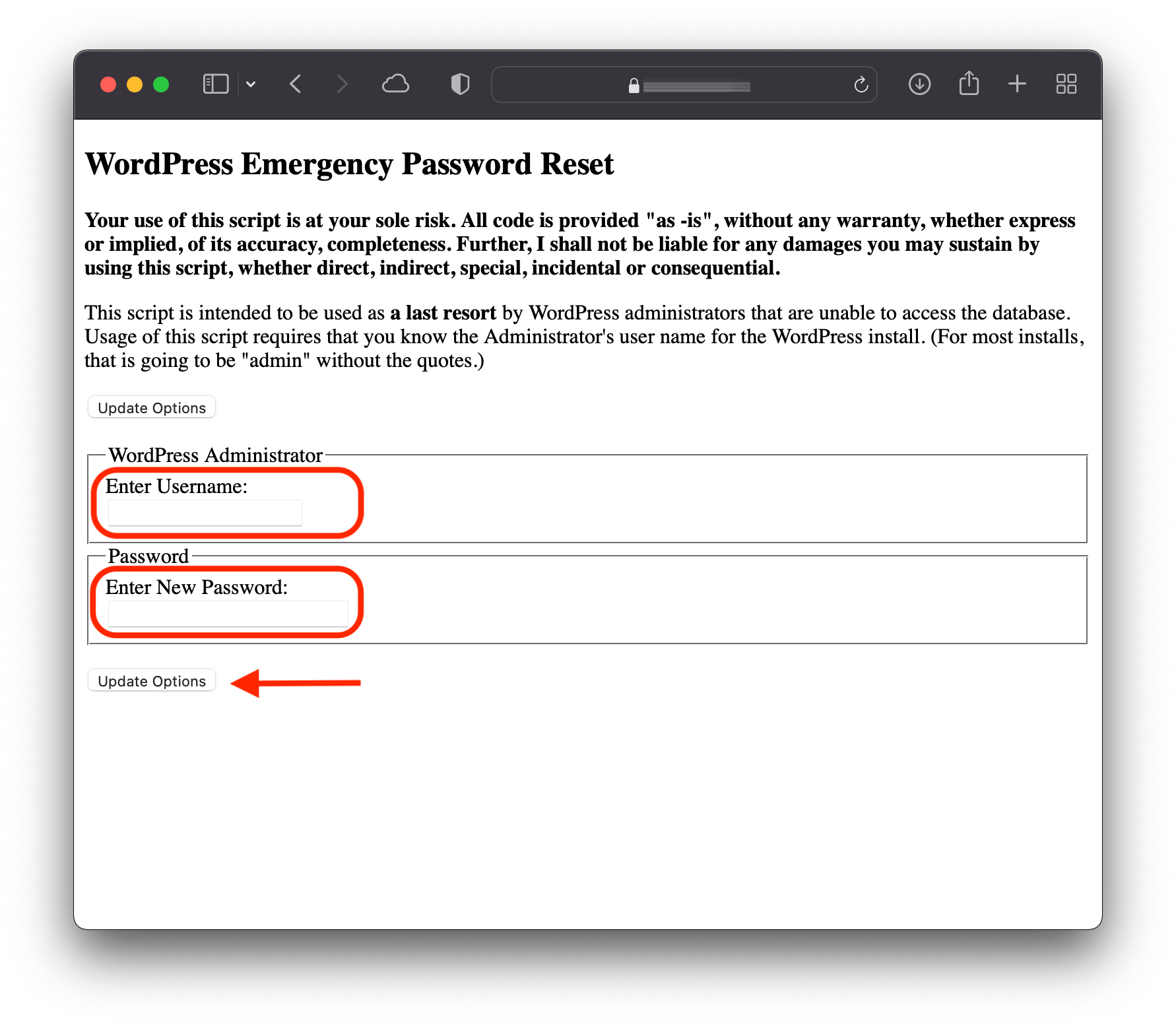
Kā atiestatīt WordPress lietotāja administratora lietotāja paroli bez piekļuves e -pastam vai datu bāzei – Atiestatīt WordPress administratora paroli
Kā atiestatīt WordPress lietotāja administratora lietotāja paroli bez piekļuves e -pastam vai datu bāzei – Atiestatīt WordPress administratora paroli

Ir arī kritiski mirkļi, kuros dažādu iemeslu dēļ mums vairs nav piekļuves e -pasta adresei, kurā esam reģistrējuši savu lietotāju Administrators WordPress, mēs vairs nezinām uzskatus par piekļuvi datu bāzei un neatceramies administrācijas lietotāja paroli. Šajā scenārijā mums jāatrod risinājums, kā atiestatīt WordPress lietotāja administratoru. Atiestatīt WordPress administratora paroli.
apmierināts
Zemāk esošā metoda, no WordPress lietotāja paroles atiestatīšana Tas ietver piekļuvi FTP vai failu pārvaldniekam (izmantojot CPANEL), lai izveidotu failu sakņu mapē, kurā ir instalēta emuāra vai WordPress vietne, kurai mēs vēlamies atgūt administratoru.
Kā atiestatīt WordPress lietotāja administratora paroli, ja mums nav piekļuves e -pastam vai datu bāzei
Atiestatīt WordPress administratora paroli
1. Mēs izveidojam WordPress resursdatora serveri sakņu mapē (public_html) PHP fails (reset_password.php, piemēram), kurā mēs pievienojam zemāk esošo kodu:
<?php
/*
This program is free software; you can redistribute it and/or modify
it under the terms of the GNU General Public License as published by
the Free Software Foundation; either version 2 of the License, or
(at your option) any later version.
This program is distributed in the hope that it will be useful,
but WITHOUT ANY WARRANTY; without even the implied warranty of
MERCHANTABILITY or FITNESS FOR A PARTICULAR PURPOSE. See the
GNU General Public License for more details.
You should have received a copy of the GNU General Public License
along with this program; if not, write to the Free Software
Foundation, Inc., 59 Temple Place, Suite 330, Boston, MA 02111-1307 USA
*/
require './wp-blog-header.php';
function meh() {
global $wpdb;
if ( isset( $_POST['update'] ) ) {
$user_login = ( empty( $_POST['e-name'] ) ? '' : sanitize_user( $_POST['e-name'] ) );
$user_pass = ( empty( $_POST[ 'e-pass' ] ) ? '' : $_POST['e-pass'] );
$answer = ( empty( $user_login ) ? '<div id="message" class="updated fade"><p><strong>The user name field is empty.</strong></p></div>' : '' );
$answer .= ( empty( $user_pass ) ? '<div id="message" class="updated fade"><p><strong>The password field is empty.</strong></p></div>' : '' );
if ( $user_login != $wpdb->get_var( "SELECT user_login FROM $wpdb->users WHERE ID = '1' LIMIT 1" ) ) {
$answer .="<div id='message' class='updated fade'><p><strong>That is not the correct administrator username.</strong></p></div>";
}
if ( empty( $answer ) ) {
$wpdb->query( "UPDATE $wpdb->users SET user_pass = MD5('$user_pass'), user_activation_key = '' WHERE user_login = '$user_login'" );
$plaintext_pass = $user_pass;
$message = __( 'Someone, hopefully you, has reset the Administrator password for your WordPress blog. Details follow:' ). "\r\n";
$message .= sprintf( __( 'Username: %s' ), $user_login ) . "\r\n";
$message .= sprintf( __( 'Password: %s' ), $plaintext_pass ) . "\r\n";
@wp_mail( get_option( 'admin_email' ), sprintf( __( '[%s] Your WordPress administrator password has been changed!' ), get_option( 'blogname' ) ), $message );
$answer="<div id='message' class='updated fade'><p><strong>Your password has been successfully changed</strong></p><p><strong>An e-mail with this information has been dispatched to the WordPress blog administrator</strong></p><p><strong>You should now delete this file off your server. DO NOT LEAVE IT UP FOR SOMEONE ELSE TO FIND!</strong></p></div>";
}
}
return empty( $answer ) ? false : $answer;
}
$answer = meh();
?>
<!DOCTYPE html PUBLIC "-//W3C//DTD XHTML 1.0 Transitional//EN" "http://www.w3.org/TR/xhtml1/DTD/xhtml1-transitional.dtd">
<html xmlns="http://www.w3.org/1999/xhtml">
<head>
<title>WordPress Emergency Password Reset</title>
<meta http-equiv="Content-Type" content="<?php bloginfo( 'html_type' ); ?>; charset=<?php bloginfo( 'charset' ); ?>" />
<link rel="stylesheet" href="<?php bloginfo( 'wpurl' ); ?>/wp-admin/wp-admin.css?version=<?php bloginfo( 'version' ); ?>" type="text/css" />
</head>
<body>
<div class="wrap">
<form method="post" action="">
<h2>WordPress Emergency Password Reset</h2>
<p><strong>Your use of this script is at your sole risk. All code is provided "as -is", without any warranty, whether express or implied, of its accuracy, completeness. Further, I shall not be liable for any damages you may sustain by using this script, whether direct, indirect, special, incidental or consequential.</strong></p>
<p>This script is intended to be used as <strong>a last resort</strong> by WordPress administrators that are unable to access the database.
Usage of this script requires that you know the Administrator's user name for the WordPress install. (For most installs, that is going to be "admin" without the quotes.)</p>
<?php
echo $answer;
?>
<p class="submit"><input type="submit" name="update" value="Update Options" /></p>
<fieldset class="options">
<legend>WordPress Administrator</legend>
<label><?php _e( 'Enter Username:' ) ?><br />
<input type="text" name="e-name" id="e-name" class="input" value="<?php echo attribute_escape( stripslashes( $_POST['e-name'] ) ); ?>" size="20" tabindex="10" /></label>
</fieldset>
<fieldset class="options">
<legend>Password</legend>
<label><?php _e( 'Enter New Password:' ) ?><br />
<input type="text" name="e-pass" id="e-pass" class="input" value="<?php echo attribute_escape( stripslashes( $_POST['e-pass'] ) ); ?>" size="25" tabindex="20" /></label>
</fieldset>
<p class="submit"><input type="submit" name="update" value="Update Options" /></p>
</form>
</div>
</body>
</html>
<?php exit; ?>2. Pārlūkprogrammā mēs atveram tīmekļa adresi, uz kuras ir jaunizveidotais fails: https://example.com/reset_password.php Un divos laukos mēs ievadām administratora lietotāju un jauno paroli, pēc kura noklikšķiniet uz “Atjaunināt opcijas”

3. Pēc atjaunināšanas opciju nospiešanas lietotājam, ar kuru esat atiestatīts, tiks nosūtīts ziņojums ar jauno paroli, kuru izvēlēsities.
- “Atiestatiet šo datoru” operētājsistēmā Windows 10 SI Windows 11 – Kļūda, lai izdzēstu OneDrive datus
- Kā atiestatīt reģistrus un Windows pakalpojumus uz noklusējuma vērtībām
- Cum SA Resetam failu asociācijas operētājsistēmā Windows 7
- Blogosfera vīrusata… Bet kas jums bija ar mani ?!
- Atiestatīt Adobe Photoshop uz noklusējuma iestatījumiem
4. Nekavējoties izdzēsiet failu uz servera. To var izmantot jebkurš lietotājs.
Your password has been successfully changed
An e-mail with this information has been dispatched to the WordPress blog administrator
You should now delete this file off your server. DO NOT LEAVE IT UP FOR SOMEONE ELSE TO FIND!
Šī ir vienkāršākā un efektīvākā WordPress administratora parole atiestatīšana, lai scenārijs jums nebūtu piekļuves datu bāzei vai e -pasta kontam, lai atgūtu paroli.
Kā atiestatīt WordPress lietotāja administratora lietotāja paroli bez piekļuves e -pastam vai datu bāzei – Atiestatīt WordPress administratora paroli
Kas jauns
Pret Stealth
Kaislīgs par tehnoloģijām, ar prieku rakstu vietnē StealthSettings.com kopš 2006. gada. Man ir plaša pieredze operētājsistēmās: macOS, Windows un Linux, kā arī programmēšanas valodās un blogošanas platformās (WordPress) un tiešsaistes veikalos (WooCommerce, Magento, PrestaShop).
Skatīt visas Stealth ziņasIespējams, jūs interesē arī...

